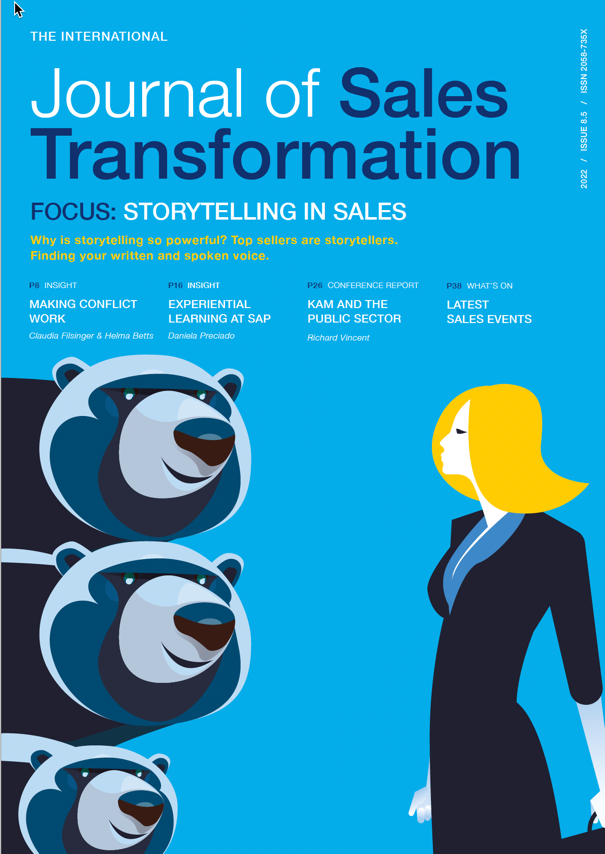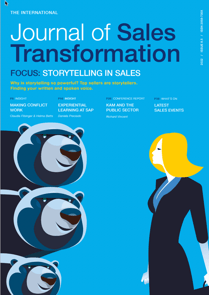Top sellers are storytellers
October 12, 2022

This article first appeared in the October 2022 edition of the International Journal of Sales Transformation, and is reproduced with their permission. The theme of this edition of the IJoST focuses on a topic that is very close to my heart - the critical importance of storytelling in B2B selling:
 As human beings, we have evolved over the generations to use stories to communicate - and one of the key factors that now sets today’s most effective salespeople apart from the rest is their ability to share compelling, relevant anecdotes (typically the experiences of other existing customers) that resonate with their prospective customers, stimulate them to think differently, and cause them to take action.
As human beings, we have evolved over the generations to use stories to communicate - and one of the key factors that now sets today’s most effective salespeople apart from the rest is their ability to share compelling, relevant anecdotes (typically the experiences of other existing customers) that resonate with their prospective customers, stimulate them to think differently, and cause them to take action.
Storytelling is an ancient art, dating back to the dawn of language - and the three core rhetorical skills that underpin compelling and persuasive storytelling can be traced back to Aristotle: ethos (the credibility of the storyteller), pathos (the ability to appeal to one’s audience), and logos (the ability to support one’s assertions through evidence).
Some people clearly appear to have a “natural gift” for storytelling. You’ve probably come across a number of these people in your working or personal lives, and been struck by their ability to communicate, influence, and persuade. You may well have decided to buy things on the strength of the seller’s skills.
But storytelling is not just an innate gift - it is a skill that can and should be developed. Every salesperson has the potential to improve their storytelling skills. Let’s start by exploring Aristotle’s three modes of persuasion.
Ethos
Ethos reflects the perceived authority and credibility of the storyteller. Clearly, the salesperson telling a story must come across as being personally credible. But because - in the sales world, at least - the salesperson is representing the collective authority and credibility of the organisation, they do not have to have direct personal experience of the story they are telling.
An individual salesperson’s ability to tell effective stories would be extremely limited if this were to be the case. Fortunately, customers understand and expect that the stories and anecdotes being shared reflect the shared experience over time of the organisation, and not just the salesperson.
So, one of the most obvious ways of improving a sales organisation’s collective storytelling abilities is to consciously collect and share a growing pool of relevant anecdotes, make them accessible to every member of the team, and give them all the confidence to share them. If you’re not already doing this, you should. The return on what is usually a modest investment will be huge.
Pathos
Pathos reflects the ability of the storyteller to appeal to their audience’s emotions. The most powerful prescription here is for the salesperson to put themselves in their audience’s shoes, to be sensitive to their situation and environment, and to understand their challenges and aspirations. I’d go as far as to say that if you’re not aware of your audience, you will never be an effective storyteller.
This is as much (or more) to do with mindset than it is with skillset. If a salesperson is not genuinely curious about their prospective customer and about the outcomes that they are striving to achieve, chances are they will either not use anecdotes at all, tell an inappropriate anecdote or tell an appropriate anecdote so badly that it fails to resonate.
This is where first-level managers can have a tremendous impact - by coaching and encouraging their salespeople to apply the necessary curiosity and awareness, and by practicing the necessary skills in roleplays.
Logos
No matter how persuasively delivered, unsupportable claims tend to get found out if they are not backed up by evidence. Effective storytelling therefore depends on the presence of proof and supportable facts.
But this is not just about having accurate facts at your fingertips. I’ve come across situations where the selectively quoted proof-points (although accurate) came across as quite literally incredible to the audience. It’s best not to use exceptional or extreme data even if true, but to use closer-to-the-average data points that credibly reflect the reasonable expectations of the typical customer.
There is one rhetorical technique that - if used appropriately - can prove very persuasive. This is the “unexpected benefit”. After sharing the to-be-expected results that an existing customer has achieved, adding a phrase along the lines of “... but that wasn’t all - in addition they were pleasantly surprised to achieve [UNEXPECTED ADDITIONAL BENEFIT]” - this further strengthens the credibility of the whole story.
A few more guidelines
Mastering ethos, pathos and logos remain just as central to the art of effective storytelling as they were in Aristotle’s day. Here are a few more guidelines...
Reflect the reality of the journey
Your customers know that life is complicated, and that any worthwhile achievement will inevitably include a few twists and turns along the way. Make sure you reflect that in your story - don’t pretend or position that the path to success is always smooth and straightforward.
Rather than a simple problem-and-solution story (“we started at A and ended up at Z”), make sure that your story includes some credible complications, for example:
- What drew the customer’s attention to the issue in the first place?
- How had they initially tried to address it, and with what results?
- What impact was the issue having on their ability to achieve their desired outcomes?
- What setbacks and obstacles stood in their way?
- How did your organisation enable them to see a way forward?
- How did you put them on the path to success?
- What unexpected additional benefits did they achieve?
These sort of elements (as long as you don’t over-complicate them, or extend the telling-of-the-tale too long) make for a much more compelling story - and they have a richness that few conventional over-sanitised published case studies can offer.
Resist the itch to pitch!
Many salespeople - the moment a potential customer either acknowledges a problem they believe they can solve or shares a need they believe they can address - can’t resist the temptation to present their “solution”. Unfortunately, from that point on, there’s often no good way back.
Premature pitching is one of the most common - and one of the most undesirable - sales habits. If your story causes your prospective customer to become engaged and want to learn more, you need to stick with the issue they have acknowledged and find out more. How long have they suffered from the issue? How have they tried to deal with it? What would happen if they continued to follow their current path and the status quo prevailed?
Sticking with the issue allows you to learn more about the customer’s situation and their potential motivations. It will probably offer the opportunity to share another valuable anecdote. And when you finally get around to presenting your solution, it will have a far better chance of hitting the mark.
Use their language, not yours
There’s almost nothing that spoils a potentially compelling story more effectively than using terms and acronyms that are familiar to the seller, but unfamiliar to your audience. Listen carefully to the words and phrases your prospective customer uses and align your language accordingly. Above all, avoid derailing a conversation about business issues by descending into impenetrable acronyms or technobabble.
Mastering the art of story telling
Storytelling is an art that can and should be mastered by every salesperson. In addition to gathering all your organisation’s stories into an accessible resource, you should invest in giving your salespeople the chance to practice in front of their peers. They will inevitably learn a lot from their colleagues with regard to both content and technique - and they will have much more valuable conversations with their customers.
About the Author
 Bob Apollo is a Fellow of the Association of Professional Sales, a founding contributor to the International Journal of Sales Transformation, a recognised Sales Futurist, an active member of the Sales Experts Channel, and the driving force behind Inflexion-Point Strategy Partners, the leading proponents of outcome-centric selling.
Bob Apollo is a Fellow of the Association of Professional Sales, a founding contributor to the International Journal of Sales Transformation, a recognised Sales Futurist, an active member of the Sales Experts Channel, and the driving force behind Inflexion-Point Strategy Partners, the leading proponents of outcome-centric selling.
Following a successful corporate career spanning start-ups, scale-ups and market leaders, Bob now works as a strategic advisor, mentor, trainer and coach to ambitious B2B sales organisations - teaching them how to differentiate themselves through their provably superior approach to achieving their customer's desired outcomes.


Comments